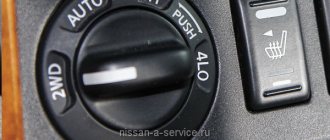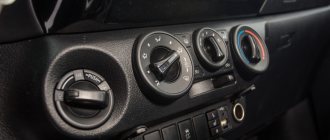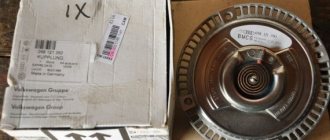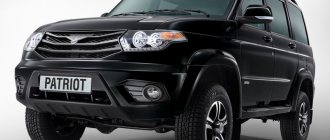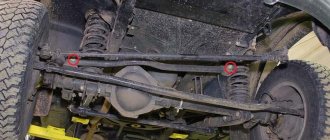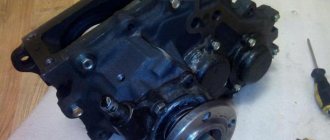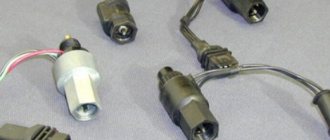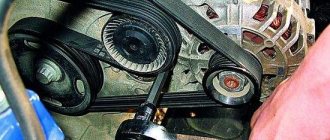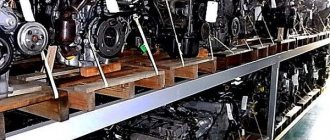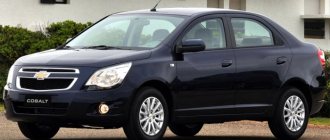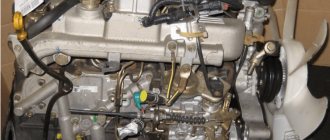SUVs are equipped with a 2-axle drive system, which allows you to drive on soft ground or in off-road conditions. The car owner needs to know how to enable all-wheel drive on a UAZ Patriot, which can be equipped with transfer gearboxes of several types (this depends on the year of manufacture of the vehicle). Depending on the gearbox model, a lever or a rotary washer is used to shift.
Washer or lever for switching the drive.
How the all-wheel drive system works
The Patriot's engine is connected to a 5-speed synchronized manual transmission. The secondary shaft of the box transmits torque to a 2-stage transfer gearbox, which is connected to the axles using cardan shafts with needle bearings and movable couplings. Splined couplings ensure the operation of the transmission when the axle moves on a suspension. The drive to the rear beam operates in continuous mode; the driver turns on the front axle when driving off-road.
The classic UAZ transfer gearbox is equipped with gears with straight teeth, which are switched using a lever. The gearbox housing parts are made of cast iron, the primary and secondary shafts are located inside, and there is an intermediate element with a movable carriage. The gearbox cover houses a switching mechanism equipped with two rods and forks. The mechanism is connected to a lever located inside the car.
The Dymos gearbox (with an aluminum crankcase), used since the summer of 2013, uses a chain to transmit power to the wheels, and the design includes a double synchronizer (when all-wheel drive is engaged in direct drive). The manufacturer claims a gearbox life of 200 thousand km, but with frequent use of the vehicle in severe off-road conditions, the unit fails earlier. To change gears, an electric servo drive is used, connected to a control puck.
The car's all-wheel drive distributes torque between the axles in a 50/50 ratio. There is no center differential in the transmission design. The rear axle is equipped with a differential; axle shafts installed inside the axle stockings are used to transmit torque to the wheels. To supply torque to the front wheels, axle shafts and steering knuckles with hinges are used. The units allow power to be transmitted to the steered wheels. The front axle housing also has a cross-axle differential.
On cars manufactured before 2007, factory couplings (hubs) were installed in the front wheel hubs. The devices allow you to disconnect the hubs from the axle shafts and differential, which has a positive effect on fuel consumption. The products are equipped with splined couplings; a special rotary washer in the center of the hub is used to control the position. The plant refused to install hubs in order to simplify the design of the vehicle, but owners of Patriot vehicles can install the hubs themselves.
How the UAZ front axle works
The diagram of the UAZ loaf front axle allows us to determine that it consists of several components:
Below is the structure of the components of the front axle of the UAZ loaf car.
Carter
The UAZ loaf axle housing consists of 2 parts. The parts are bolted together to form a gearbox housing. Parts of the crankcase are equipped with fastenings for installing springs and shock absorbers.
IMPORTANT: As the vehicle is used, the lubricant in the crankcase heats up and expands. At the same time, the pressure in the crankcase cavity increases. To prevent leakage of the axle housing, a breathing valve is provided. It is installed on the axle housing of the UAZ front axle and is necessary to communicate the crankcase cavity with the atmosphere.
There are turning mechanisms along the edges of the bridge. They are necessary to drive a car. The mechanisms are pivotally connected to the edges of the crankcase casing. Trunnions are installed on the rotating mechanisms. They are necessary for articulated connection with the vehicle hubs. To reduce the degree of friction, the hub is mounted on roller bearings.
Gearbox
The UAZ loaf front axle gearbox consists of a main gear and a cross-axle differential. When the front axle of the UAZ loaf is turned on, the torque from the gearbox is supplied through the driveshaft to the gearbox flange. It is mounted on the same shaft with the main gear drive gear.
As the drive gear rotates, it transmits torque to the driven gear. Compared to the drive gear, it has a large diameter. This allows you to reduce the torque transmitted from the transfer case.
REFERENCE: The teeth of the gears of the main gear of the UAZ vehicle gearbox are located at an angle. This prevents the gear teeth from hitting each other, thereby reducing the noise level when the vehicle is moving.
An interwheel differential is located inside the driven gear. It consists of conical satellites and their axes. The differential mechanism includes axle shaft splines. The differential allows, when turning a car, to achieve a difference in the speed of rotation of the wheels of one axle. You can also read about UAZ 390945.
Half shafts
The front axle of the UAZ loaf car is a shaft with splines on the edges. On the one hand, the splines are installed in the differential gearbox. The second side of the axle shaft drives the wheel hub. The transmission of torque from the front axle gearbox to the wheel mechanism is carried out using a CV joint. It allows you to transmit torque regardless of the angle of rotation of the wheel mechanisms.
A distinctive feature of the front axle of the UAZ Bukhanka is the ability to disconnect the wheel hubs from the axle shafts. This is necessary to prevent wear of the rotating parts of the gearbox during prolonged movement on good quality surfaces.
Turning on all-wheel drive on a UAZ Patriot
UAZ vehicles assembled before 2013 have a standard transfer case. To change operating modes, a separate lever is used, located on the tunnel between the front seats. The handle allows you to turn the drive to the front axle on or off, as well as select direct or reduced speed in the gearbox. A spherical plate is mounted on the handle, on which the gearbox switching algorithm is indicated.
After the introduction of the Hyundai Dymos transfer gearbox (developed in South Korea), a rotary washer mounted on the center console is used to switch transmission modes.
The use of electronics allows you to turn on the all-wheel drive mode on the go (at speeds up to 100 km/h). But to engage a downshift, you need to stop and move the main gearbox lever to the neutral position (with the clutch released). Then the washer is moved to the right, and the clutch is depressed until the indicator on the panel turns on.
Operating modes of the Dymos gearbox:
- Transfer case UAZ “Loaf”: Design and principle of control of the transfer case
- Standard 2H, used when operating a vehicle on highways or dirt roads with hard surfaces (in summer and winter).
- All-wheel drive mode with direct 4H transmission, activated when driving on wet or slippery dirt or asphalt roads. When the drive is turned on, a control indicator on the instrument panel is activated. The factory recommends switching the mode only when driving in a straight line. Activation of the drive on 2 axles when moving in an arc leads to shock loads on the transmission units. If, when turning the washer, the drive to the front axle does not turn on, then you need to increase or decrease the speed and then try again.
- The lowered row 4L is used when driving in difficult road conditions or when moving a trailer through mud or deep snow (up to 400 mm or more). The mode provides an increase in torque at the wheels; a warning lamp lights up on the instrument cluster. When driving, it is forbidden to jerk the car sharply with the engine, since the chain mechanism does not tolerate shock loads and is destroyed.
Dymos transfer case with gear ratio 4.11.
When all-wheel drive is connected, the gearbox may produce extraneous sounds accompanied by body vibration. When operating a vehicle with front axle drive, controllability deteriorates (the angle of rotation of the wheels decreases), and vibrations occur when the steering wheel rotates. The use of the drive on dry roads leads to increased fuel consumption and additional noise, and also negatively affects the service life of tires and transmission components.
To return to rear-wheel drive mode, you need to release the gas pedal and then press the clutch. At the same time, the washer is rotated to the 2H position. After the 4H indicator goes out on the instrument cluster display, the clutch pedal is released. To shift from a lower gear to a direct gear, you need to stop the car, then press the clutch pedal, then move the washer from position 4L to position 4H, wait until the indicator turns off and release the clutch.
When operating machines with a Dymos gearbox, a malfunction occurs due to spontaneous activation of the all-wheel drive. The defect is associated with erroneous switching of the unit control unit.
To restore functionality, you will need to repair the controller or replace the part along with the rotary washer. The design of the gearbox provides a diagnostic system: when faults are detected, the 4WD Check indicator turns on in the instrument cluster with simultaneous activation of the indicator of the operating mode in which the problem was detected.
Dymos gearbox diagram.
How to turn on the front axle on a UAZ Bukhanka
This page contains photos of the interior of the UAZ Bukhanka car:
Location of controls
1 - steering wheel. The steering wheel of UAZ-31512, UAZ-3153 and the UAZ-3741 family vehicles has a central horn button. The steering wheel of UAZ-31514 and UAZ-31519 cars is equipped with an energy-intensive pad and has two horn buttons located in the wheel spokes. 2 — rear view mirror (internal). Adjustable by turning around the articulated head. 3 - instrument panel. 4 — sun visors. 5 — windshield blower pipes. 6 — passenger handrail. 7 — lamp (plafond) lighting. 8 - battery ground switch. Switching the “mass” on and off is done by turning the knob 90°. 9 — lever for engaging the front drive axle. It has two positions: front - the axle is on, rear - the axle is off. Before engaging the front axle, engage the front wheels. Turn on the axle while the vehicle is moving. 10 - heater. 11 — transfer case control lever. It has three positions: forward - direct gear is engaged, middle - neutral, reverse - downshift is engaged. Before downshifting, engage the front axle. Engage the downshift with the clutch disengaged and only when the car is completely stopped. 12 — gear shift lever. The switching pattern is shown on the handle. Shift gears by smoothly pressing the lever without jerking. If you cannot engage the required gear before moving off, lightly release the clutch pedal, and then disengage the clutch a second time and engage the gear. When switching from a higher gear to a lower one, it is recommended to disengage the clutch twice and briefly press the throttle pedal. Engage reverse gear only after the vehicle has come to a complete stop. When you engage reverse, the reversing light turns on. 13 — lever of the parking brake system. To turn the lever on, move it back; to turn it off, press the button at the end of the lever and move the lever forward until it stops. When the parking brake is engaged, the red warning lamp on the instrument panel lights up. 14- handle for driving the hatch cover for ventilation and heating of the body. 15 — valve handle for switching fuel tanks. The handle is turned forward - the valve is closed, turned to the left - the left tank is on, turned to the right - the right tank is on. The valve is not installed on vehicles with one fuel tank. 16 — carburetor throttle control pedal. 17 — pedal of the service brake system. Brake the car smoothly, gradually increasing pressure on the pedal. When braking, do not let the wheels slide, as in this case the braking effect is significantly reduced (compared to rolling braking) and tire wear increases. In addition, strong and sudden braking on a slippery road can cause the car to skid. 18 — clutch pedal. When changing gears and starting from a stop, the clutch pedal should be pressed quickly and fully, and released smoothly. Depressing the pedal slowly or incompletely causes the clutch to slip, making it difficult to shift gears and causing increased wear on the clutch plate. When the pedal is suddenly released (especially when starting from a standstill), the load on the transmission increases, which can lead to deformation of the clutch driven disc and other transmission parts. When driving the car, do not keep your foot on the clutch pedal, as this leads to partial disengagement of the clutch and the disc slipping. 19 — foot switch for headlights. By pressing the button, with the headlights on, the low beam or high beam headlights are turned on. Not installed on vehicles with multifunctional left-hand stalks. 20 - portable lamp socket. 21 — radiator shutter control handle. Under certain operating modes and climatic conditions, in order to maintain the temperature of the engine coolant within 70-80 ° C, it is necessary to regulate the amount of air cooling the radiator using blinds. When the handle is pulled, the blinds close. 22 — rear view mirror (external). 23 — direction indicator switch handle. The handle automatically returns to the neutral position when the steering wheel is turned in the opposite direction (when the car enters a straight line). Some cars are equipped with multifunction steering column switches. 24 - carburetor throttle control knob. The extended handle is fixed by turning 90° in any direction. 25 - carburetor choke control handle. The extended handle is fixed by turning 90° in any direction.
Transfer case lever positions and their meanings
The classic transfer gearbox is controlled using a separate handle. The lever moves along a path in the shape of the letter P; there are a total of 4 handle positions. The position in which the lever is at the lower left point of the letter P is considered neutral.
When using a gearbox, you should take into account the presence of hubs in the front wheel hubs (installed at the factory until 2007, and then by the owners themselves). If there are elements on the machine, then it is necessary to first activate the drive by turning the handles on the hubs.
Positions of the gearbox control lever on the UAZ "Patriot":
- To disable the drive to the front axle, move the handle to the base position. In this case, torque is transmitted to the rear wheels. This operating mode is intended for operating the vehicle on paved roads in summer or winter. The plant recommends using the mode during everyday use of the Patriot car, since due to the reduced load on the engine, fuel consumption decreases. At the same time, there is a decrease in noise when the machine is moving.
- Moving the lever forward and to the right allows you to turn on the supply of torque to the front wheels (direct transmission is enabled in the transfer gearbox). The mode can be activated while moving (speed up to 60 km/h). When turning on the drive while the machine is standing, difficulties may arise due to the position of the gears in the gearbox; after moving the machine 20-30 cm forward, the drive turns on without jamming. The mode is used when driving along a wet country road and on snow-covered or icy paved roads.
- Moving the lever from position 2 to the right and back to the middle of the stroke allows you to engage the neutral position in the gearbox. In this case, the cardan shafts stop, the car remains motionless (regardless of the position of the lever in the main gearbox).
- Moving the lever to the right and all the way allows you to turn on the lower row in the transfer gearbox while maintaining the transmission of torque to the front and rear axles. The mode is used when driving in difficult road conditions (for example, in snow more than 400 mm deep or in mud reaching the center of the wheel hubs). A lower gear is used when driving in the mountains (including with a trailer) or when crossing swamps or streams.
The manufacturer prohibits the use of a 2-axle drive when driving on dry roads. When driving around curves in the highway or when making turns, the outer wheels travel a greater distance than the inner wheels. To compensate for this effect, a center differential is used, which is not provided on Patriot cars. As a result, the mechanical loads on the transmission components increase, which leads to the destruction of parts and abrasion of the tire treads.
Similar articles
UAZ Patriot rear driveshaft UAZ crosspiece UAZ Patriot instrument panel Do-it-yourself differential lock on a UAZ
Today it is impossible to imagine off-road vehicles without special equipment; such a mechanism includes the UAZ Hunter transfer case. The device helps the vehicle overcome sections of roads that would seem impassable with a classic configuration. The ability of a vehicle to move on an unpaved surface is achieved by distributing impulse to each drive wheel. As a rule, both axles of the car are involved in this.
- How to turn on the front axle on a UAZ Patriot
The transfer case on the UAZ “Hunter” is an auxiliary mechanism located next to the gearbox. The presence of the unit doubles the number of stages, and a successful combination of gear ratios increases the operational capabilities of the equipment.
Transfer case UAZ “Hunter”:
UAZ front axle structure
It consists of a crankcase (sometimes called a stocking), a differential and a final drive. The rear and front axles have no fundamental differences. The only difference is in the direction of the thread of the oil rejection ring located in the main gear. The current design of the UAZ front axle is shown in the picture below. The support placed on the casing is fixed with five hardware. Pin bushings are pressed into the support. A pair of pins “engages” in holding the fist. He also holds the housing cover of the wheel gearboxes. A pin is fixed on it along with a shield on which there are parts of the brake system.
The pins do not rotate in the fist thanks to pin-type stoppers. The fist itself is made with preload (0.02-0.1 mm). The UAZ 469 axle is adjusted using spacers. Location: between the turn lever and the trim (left or right). The spacers are located between the pads and the fist.
Bridge diagram
One of the features of the described mechanism is that, in addition to increasing cross-country ability, it also turns the wheels. For this purpose, Birnfield ball joints are used. Their cavities contain lubricant that does not need to be replenished throughout their entire service life. The cams, as well as the axis of the pins, are inclined, which allows the wheels to be returned to the middle position after making a turn. The main advantages of the beam (Spicer):
- track is 1.6 m, which has a positive effect on the stability of the car;
- the wheels rotate at an angle of up to 32 degrees, which gives the machine improved maneuverability;
- instead of leaf springs, a dependent suspension on springs is mounted;
- no need to replace lubricant in mechanisms (fists);
- removable cover facilitates access to parts in case of repair;
- the differential together with the gearbox are in one housing - this increases rigidity and service life;
- An improved satellite gear has reduced noise.
Particularly worth mentioning are the hinges, or more precisely the stabilization of angular velocity. This is a design that ensures the stability of rotation of two shafts: the drive and the accompanying. The hinge includes two forks: in their sockets there are 4 balls. In the middle sectors of the parts there is a fifth one, needed for installation operations. In particular, centering the fork. To deactivate the front-wheel drive, there is a special device consisting of a clutch, bolts, and balls.
Distinctive features of the military version
The main feature of the front axle in the military version is the placement of the gearbox. It is located higher. The second distinctive point is the gear ratio - 5.38. The civilian version of UAZ 469, 452, 3151, 3303 has 4.6 or 5.125. All these characteristics increase the distance from the bottom of the car to the road surface from 220 to 300 mm. Those who want to quickly replace an ordinary bridge with a military one will be disappointed: this will not work without alterations. The reason is in the design of the bipod and suspension. In addition, driveshafts differ in length.
A real “cart”!
UAZ Hunter transfer case device
The UAZ Hunter single-lever transfer case, the purpose of the product is to distribute the impulse removed from the power unit to the working pairs of wheels. Structurally, the unit is equipped with two stages and a reduced speed. There is no differential between the axles in the design.
The impulse arrives at the transfer case shaft after the classic gearbox. The secondary shaft is in constant contact with the main stage of the pair of wheels behind the car, the connection occurs through a cardan. Activation of the first pair of wheels connects the shafts to each other using a gear coupling, and the parts rotate at equal speeds.
Transfer case diagram:
The design contains a tray made of cast iron and closed with a plug. In addition, the composition includes shafts: main, secondary, middle, front wheel activation shaft; wheels with teeth and clutches that disengage the front wheels.
The transfer case of the UAZ “Hunter” is fixed to the pallet of the classic box with four bolts; a hermetic compound is used to seal the joint. The alignment of the products to each other occurs with the outer part of the bearing of the secondary shaft of the gearbox. The handbrake parts are attached to the rear of the transfer case. The transfer case tray contains the main, middle shafts, activation shafts of the front and rear wheels, the parts are fixed in swing bearings.
- UAZ Patriot has been updated and received a rear axle lock
Problems and solutions
The box requires periodic inspection and service. The mechanism is reliable, unpretentious and tenacious, provided it is handled correctly.
| Source of problems | Liquidation |
| Excessive device hum | |
| Weak fastening of the transfer case to the classic box, or loosening of the bearing caps. | Tighten the fasteners. |
| Cardan imbalance. | Adjust or change the product. |
| Bearing removal. | Replace worn bearings. |
| Demolition of gears. | Replace worn gears. |
| Inconsistency in the characteristics of the working fluid. | Replace with recommended fluid. |
| Low lubrication level. | Add fluid to normal level. |
| Difficult switching | |
| High degree of wear on car wheels. | Replace the wheels, set the pressure to normal. |
| Shaft connectors are jammed. | Sand, replace damaged elements. |
| Damage to gear locking devices. | Align or change the device. |
| Transmissions are “flying out” | |
| Gear teeth worn out. | Replace worn gears. |
| The gaps in the longitudinal protrusions of the shaft have been increased. | Provide normal spacing. |
| Demolition of fixing devices, reduction of the force of elastic elements. | Replace worn items. |
| Leakage of working fluid | |
| Seal failure. | Replace seals. |
| Reducing the tightening level of fasteners. | Tighten fasteners. |
| Damage to seals. | Replace sealing elements. |
| Potholes and pores are not on the surface of the frame. | Change the skeleton elements. |
Switching transfer case UAZ Hunter
The transfer case is controlled and activated from the driver's cab, remotely. To do this, the user uses the levers located on the right side in relation to him. It is noteworthy that the machine, depending on the installed configuration, uses both single-lever and double-lever gearbox control designs.
The inclusion of a lower gear by an activating mechanism with one lever is accompanied by an independent shift of the lever at the end point, under the influence of a spring element, to the left side (towards the driver).
Transfer case shift lever positions:
The procedure for turning off a lower gear is accompanied by a preliminary shift of the lever to the right until it stops (in the direction of travel of the car). After which the lever moves to the zero position, forward in the direction of movement of the machine.
When working with a mechanism that controls the transfer case with two levers, take into account that the top switch drives the front pair of wheels. Device positions: first (wheel set on), second (wheel set off). The transfer case is controlled by three positions: first (main gear is working), second (zero position), third (low gear is activated).
IMPORTANT!: To prevent breakage of the transfer case gear teeth when switching gears, you can activate and deactivate the device (direct and low gear) only after the machine has completely stopped.
Connection diagram for the front axle UAZ loaf
Some car owners are wondering how the front axle on a UAZ loaf is engaged? The front axle is engaged in two ways:
- A lever installed in the cab. The lever controls the transfer case. When the front axle of the UAZ loaf is turned on using a lever installed in the cabin, torque from the transfer case is transmitted along the driveshaft to the drive axle.
- Using couplings installed in wheel mechanisms. It is possible to disconnect the drive axle hub from the axle shaft. Switching the UAZ Bukhanka front axle on and off using clutches allows you to reduce the load on the gearbox when driving on hard surfaces.
IMPORTANT: after disconnecting the clutches located in the wheel mechanisms, connecting all-wheel drive using a lever from the passenger compartment will be impossible.
To engage the clutch, it is necessary to remove the protective cover of the drive axle hub. Using a hexagon, screw the coupling cap until it stops. The axle shaft splines will engage and the hub will be connected to the gearbox. To disengage the clutch, perform the procedure in reverse order.
To connect all-wheel drive using a lever installed in the passenger compartment, it is necessary to do the following:
- Disengage the clutch;
- Set the gearshift lever to neutral position;
- Move the control lever to the extreme forward position;
- After completing the steps, all-wheel drive will be turned on. All-wheel drive must be turned off by moving the lever to the rearmost position.
ATTENTION: Before disabling or engaging the front axle on a UAZ loaf, you must disengage the clutch. To do this, depress the clutch pedal located in the cabin.
Lubricant change
A dispensing device is a product whose breakdown occurs extremely rarely, since the mechanism is reliable, simple and technologically advanced. However, the procedure for replacing the working fluid is required to confirm the above.
The plant that produces transfer cases for the UAZ “Hunter” provides for manipulations every 30,000 km. The volume of liquid being poured is 0.7 liters. For filling, transmission lubricant is purchased that meets the criteria: 75W90, class GL-3.
IMPORTANT!: The old oil is drained after completing a trip by car, no later than fifteen minutes from the moment of stopping.
Change of oil:
